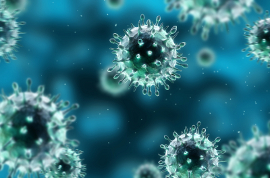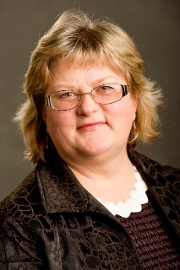Two Steps Ahead of the Flu
By Jacqueline Mitchell
Researchers are learning more about the spread of influenza—and what you can do to stay healthy

Once you’ve come down with the flu—thanks to a virus like this—you’re contagious for five to 10 days after the onset of symptoms, whether or not you feel better. Photo: iStock
Everyone knows the feeling. One minute, you’re OK. The next, you feel feverish, achy and exhausted. The sudden onset of symptoms—that “hit-by-a-truck” sensation—is one of the hallmarks of the influenza viral infection. Add chills and a severe dry cough that causes chest discomfort, and it’s pretty likely you’ve caught the flu.
’Tis the flu season in North America now, and while the virus has garnered less media attention this year than the novel H1N1 strain did last year, influenza is a major concern for public health officials. More than just an inconvenience, the virus affects between 25 and 50 million Americans and kills up to 40,000 people every year.
But who, where and when the flu strikes depends on myriad variables that differ slightly every season. The computational epidemiologist Elena Naumova, director of the Tufts Initiative for Forecasting and Modeling of Infectious Diseases, models infectious diseases like the flu, with the goal of uncovering previously unrecognized patterns in outbreaks.
To create a model, Naumova’s team compiles a series of maps—each one a snapshot of flu prevalence at a given time. When the data from these maps are superimposed and animated, the resulting model can help public health officials anticipate trends during flu season. Last year, she and her colleagues crunched the numbers for the last 13 influenza seasons in the United States. The resulting maps showed that among those 65 and older, the flu season peaks in the western part of the country first, then the upper Midwest, followed by the eastern seaboard.
The findings have practical public health implications. Why not send limited vaccine supplies to states like Nevada that experience flu outbreaks earlier? “The distribution of the vaccine should be different,” says Naumova, who is also a professor in the School of Engineering and holds appointments at the School of Medicine and the Friedman School. Under the current system, “whatever state asks loudest or is best organized gets the vaccine first,” she says.
Scientists aren’t exactly sure why the flu is seasonal in the first place. Influenza peaks during the cold weather months in both hemispheres, and tends to be less virulent in warm places, leading many to suspect the seasonality has something to do with our tendency to stay cooped up inside together when the temperature falls. That’s one reason school closings as a preventative measure are unlikely to contain flu outbreaks. “The same kids will all be playing video games together in the basement the next day,” she says.

The number of occupants per household is one of the strongest predictors of contracting the flu, as is the depth and breadth of one’s social network, says Elena Naumova. Photo: Kelvin Ma
The number of occupants per household is one of the strongest predictors of contracting the flu, as is the depth and breadth of one’s social network, says Naumova. That’s why some epidemiologists have turned to mining online communities for data to help track and predict the flu. Google’s Flu Trends, for example, monitors search terms to keep tabs on flu outbreaks around the world.
But Naumova suspects Internet-based data leaves out the elderly, a large and ever-growing segment of society who account for 90 percent of flu-related deaths each year, according to the Centers for Disease Control and Prevention. The CDC monitors every flu season using voluntary reports from doctors and hospitals across the country. But Naumova doesn’t believe that data tells the whole story, either. “Our existing surveillance system isn’t providing sufficient cover,” she says.
While influenza reports mainly come from big, urban hospitals, 70 percent of U.S. seniors live in more rural parts of the country, Naumova says. Other data about how flu affects the nation’s elderly tends to come from nursing homes. But not all elderly live in nursing homes, Naumova points out, and those who do are frailer and sicker than the seniors who are living on their own.
For a more accurate picture, Naumova and her team now are looking at older adults with HIV—an unprecedented demographic. “We don’t yet know the best vaccination policy for this group,” says Naumova. “It would be valuable to understand how to protect this vulnerable and growing sector of the population.”
She’s also mapping how so-called snowbirds—retirees who summer in places like New England and New York but spend the winter in warmer states—affect the flu’s trajectory across the country. “We’re trying to separate the seasonal patterns from those who move around during the holidays,” she says. Do they bring the virus south with them, causing flu to peak earlier in Florida and Arizona? When would be the best time to vaccinate this group? Knowing the answers to those questions could help public health officials manage flu season in the warm states.
Vaccines and Hand Washing
But there are still significant unknowns about the spread of influenza. The influenza virus, which infects the respiratory system from the lungs to the nasal passages, is transmitted through the droplets we spray when we cough, sneeze or speak. Researchers aren’t sure if the virus can also jump from person to person via contaminated surfaces, like door knobs or stairway railings.
That’s why Kanchan Ganda, a physician and a professor in the department of public health and community service at the School of Dental Medicine, encourages frequent hand washing. The dental school’s flu point-person, Ganda oversees vaccination drives for the school’s faculty, students and staff and also helps make quarantine decisions, which are especially important for the clinics the dental school operates. “We see a diverse population in our clinics, and not everyone is in optimal health. If you are not careful, you could be transmitting your infection to this susceptible population,” she says.
Given that the flu can have serious health consequences, it’s important to distinguish the flu from the common cold. Both are viruses, and therefore can’t be treated with antibiotics, which combat only bacterial infections, and both infect the respiratory system. While flu and cold symptoms overlap, colds in general are much less severe.
A cold is more likely to cause a stuffy or runny nose and a productive cough, while a dry, hacking cough that causes chest discomfort is a tipoff you’ve got the flu. In general, severe exhaustion, aches and pains, a fever higher than 100 degrees F and symptoms that linger for more than a week indicate influenza.
In the Northeast, the flu season peaks in late December and January, but Ganda advises getting vaccinated as early as possible, especially health-care workers and people who are most vulnerable to the flu, like pregnant women, infants, the elderly and those who have weakened immune systems.
Though the flu shot is up to 90 percent effective in preventing infection, millions of Americans catch the virus each year. Once you’ve come down with the flu, you’re contagious for five to 10 days after the onset of symptoms, whether or not you feel better.
Unfortunately, you are also contagious for about 24 hours before you even get sick, says Ganda. So, should you suddenly feel feverish, achy and chilled, Ganda has simple, motherly advice. “Go home and watch as much TV as possible so you can bounce back more quickly.”
Jacqueline Mitchell can be reached at jacqueline.mitchell@tufts.edu.
